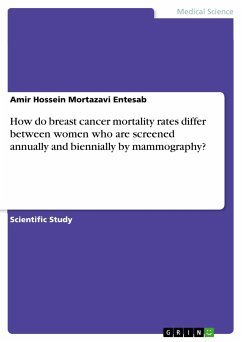Scientific Study from the year 2015 in the subject Medicine - Neoplasms, Oncology, Saba University School of Medicine (Medical School), language: English, abstract: It is this review’s hypothesis that annual mammography is proving to be statistically more beneficial than biennial screening in the reduction of breast cancer mortality rates. Breast cancer is the most common non-skin cancer and second deadliest cancer for women. Mammography, an X-ray of the breast, serves as the primary diagnostic tool for breast cancer detection as it reduces the risk of death through early detection and treatment of the disease. The medical community, however, has not agreed on how frequently such screenings should be performed. Various organizations have produced different guidelines regarding the suggested frequency of routine mammograms. For example, the United States Preventive Services Task Force (USPST) endorses biennial mammography screenings for females ages 50-74, whereas the American Cancer Society (ACS) advocates annual mammography screenings for women beginning at age 40.

